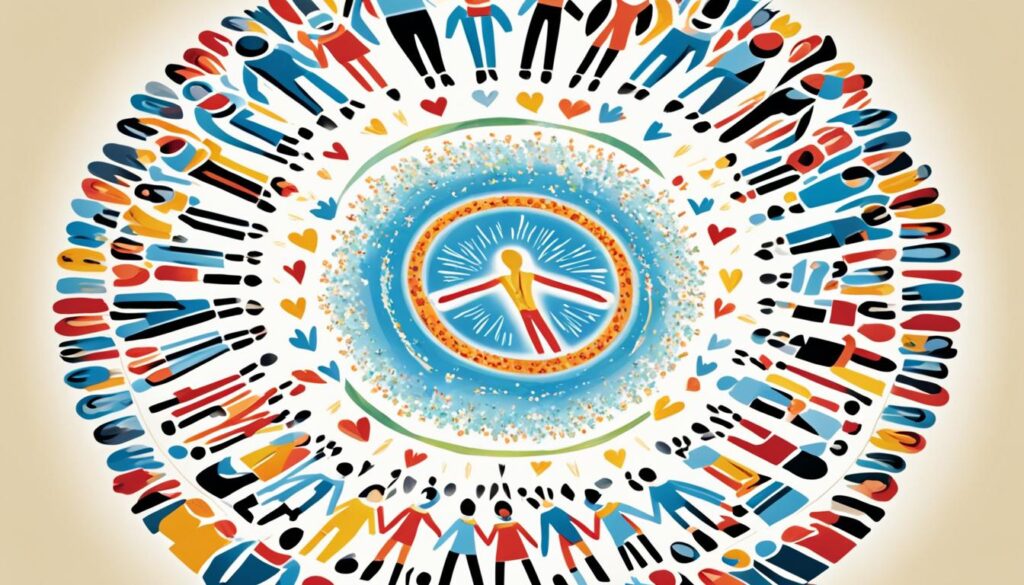If you’re whispering to yourself, “I’m so broken,” it’s important to remember that healing is possible. While it may feel overwhelming, there are ways to find solace and begin the journey towards inner peace and healing from heartache. This article will explore various techniques and insights that can help you navigate through emotional pain and find the light in your life again.
As a famous Buddhist quote reminds us, “The wound is the place where the light enters you.” This ancient wisdom recognizes that our brokenness can be the catalyst for transformation and growth. It is through acknowledging our pain and seeking healing that we can find the strength to rise above and rediscover our inner radiance.
Key Takeaways:
- Healing is possible even when you feel broken.
- Embracing your pain allows for transformation and growth.
- Exploring various techniques can help navigate emotional pain.
- Seeking solace and inner peace is a journey worth embarking on.
Embracing Mindfulness and Compassion Through Buddhism
Buddhism’s impact on personal and societal harmony is profound. By embracing the teachings of Buddhism, we can cultivate mindfulness and compassion, paving the way towards inner peace and healing. Mindfulness allows us to observe and accept our brokenness without judgment, while compassion reminds us to treat ourselves and others with kindness and understanding. Together, these practices foster healing and growth, enabling us to navigate our journey towards personal harmony and contribute to societal harmony.

| Benefits of Embracing Buddhism’s Teachings: | Principles |
|---|---|
| 1. Cultivating awareness of thoughts and emotions | Mindfulness |
| 2. Observing and accepting brokenness without judgment | Mindfulness |
| 3. Treating oneself and others with kindness and understanding | Compassion |
| 4. Fostering healing and growth | Compassion |
The Power of Mindfulness
Mindfulness is the practice of being fully present and aware of the present moment, without judgment. It allows us to observe our thoughts and emotions from a place of detachment, gaining insight into our suffering and finding acceptance. By cultivating mindfulness, we can begin to break free from the cycle of negative thoughts and emotions that keep us trapped in a state of brokenness. Through this practice, we develop the capacity to acknowledge our pain while remaining grounded in the present moment, finding solace and personal harmony.
Unleashing Compassion
Compassion lies at the heart of Buddhism, emphasizing kindness and understanding towards ourselves and others. By extending compassion to ourselves, we acknowledge our brokenness, offering love and forgiveness instead of self-criticism and judgment. This self-compassion opens the door to healing and growth, allowing us to learn from our experiences and move forward on our journey. Similarly, by practicing compassion towards others, we create harmonious relationships and contribute to societal harmony. Compassion reminds us that we are all interconnected, emphasizing empathy and cooperation.
“Compassion heals the wounds of brokenness, fostering personal and societal harmony.”
The teachings of Buddhism provide a path towards inner peace and healing. By embracing mindfulness and compassion, we can navigate the challenges of brokenness and find personal and societal harmony. Through self-reflection, acceptance, and the cultivation of empathy, we embark on a transformative journey towards healing and awakening. Remember, the power to heal lies within you.
Self-Care and the Journey to Healing
Emotional pain can leave you feeling shattered and broken. But amidst the darkness, there is a path to healing, and it begins with self-care. By prioritizing your well-being and embarking on a self-love journey, you can start mending your brokenness and finding inner peace.
Emotional self-care plays a vital role in the healing process. It involves engaging in activities that nurture your mind, body, and soul, allowing you to release pain and cultivate resilience. Here are some practices that can guide you on your journey:
- Journaling: Put pen to paper and let your emotions flow. Journaling provides an outlet for self-expression, allowing you to process your feelings and gain clarity.
- Practicing Gratitude: Cultivate a sense of appreciation for the present moment and the positive aspects of your life. Gratitude shifts your focus towards the good, nurturing a healing mindset.
- Engaging in Creative Pursuits: Explore your creativity through activities such as painting, writing, or playing an instrument. Creative outlets offer solace, allowing you to express yourself and find solace.
- Seeking Therapy or Counseling: Professional guidance can provide invaluable support on your healing journey. A therapist or counselor can help you navigate the challenges of healing from trauma, offering tools and insights to facilitate growth.
- Surrounding Yourself with a Supportive Community: Connect with people who uplift and understand you. Building a network of supportive individuals can provide encouragement, empathy, and a sense of belonging.
Remember, healing takes time and self-compassion. Listen to your needs, honor your emotions, and be patient with yourself as you embark on this transformative journey. Through emotional self-care and a commitment to your self-love journey, you can find solace, rebuild your spirit, and rediscover the strength within.

| Benefits of Self-Care in the Healing Process | Techniques for Emotional Self-Care |
|---|---|
| 1. Promotes emotional well-being | 1. Journaling |
| 2. Reduces stress and anxiety | 2. Practicing gratitude |
| 3. Enhances self-esteem and self-worth | 3. Engaging in creative pursuits |
| 4. Facilitates healing from trauma | 4. Seeking therapy or counseling |
| 5. Strengthens resilience | 5. Surrounding yourself with a supportive community |
Finding Support Through Relationships and Community
Going through emotional pain can feel isolating, but it’s important to remember that you don’t have to navigate it alone. Building a strong support system of friends, family, or even joining support groups can provide a safe space for you to share your feelings and experiences. These relationships and communities can offer understanding, guidance, and encouragement as you heal from heartache and move forward in life.
The Power of a Support System
When you’re feeling broken and trying to heal from heartache, having a support system can make all the difference. Surrounding yourself with people who genuinely care about your well-being can provide the emotional support and encouragement you need during this challenging time.
Your support system is there to lend a listening ear, offer advice, and remind you that you’re not alone in your journey. They can help you explore your feelings, understand your pain, and provide guidance on how to move forward. By opening up and sharing your struggles with trusted individuals, you create an opportunity for healing and growth.
Remember, a support system doesn’t have to be limited to your immediate family and friends. Support groups, whether online or in-person, can connect you with individuals who have gone through similar experiences. These groups offer a sense of camaraderie and understanding that can be incredibly comforting as you heal.
Here are a few ways to build and maintain a strong support system:
- Reach out to friends and family members who have demonstrated empathy and understanding in the past.
- Consider joining support groups or seeking therapy where you can connect with people who have experienced similar heartache.
- Engage in activities or hobbies that allow you to meet new people and build social connections.
- Be open and honest about your feelings with your loved ones, allowing them to better support you in your healing journey.
Community and Healing
Communities play an integral role in the healing process. Whether it’s a close-knit neighborhood, an online forum, or a shared interest group, communities provide a sense of belonging and understanding.
Within a community, you can find individuals who have been through similar heartbreak and have successfully healed. Their stories of resilience and growth can inspire you and serve as a reminder that healing is possible.
Moreover, communities often offer resources and support services designed to promote healing and well-being. From workshops and therapy programs to volunteer opportunities and educational resources, communities can play a vital role in your journey towards healing.
Cultivating relationships within your community can provide a sense of connection and strengthen your support system. Attend community events, engage in meaningful conversations, and be open to connecting with others who may be experiencing similar emotions.
A Supportive Environment
Creating a supportive environment is crucial in your healing journey. Your support system and community can help foster this environment, but it’s up to you to set boundaries and communicate your needs effectively.
Here are some tips for creating a supportive environment:
- Express your emotions honestly and openly with your loved ones, allowing them to understand and support you better.
- Set boundaries and communicate your needs clearly to avoid feeling overwhelmed or misunderstood.
- Surround yourself with positive influences who uplift and encourage you.
- Seek out resources, such as books, articles, and podcasts, that provide inspiration and guidance for healing.

| Benefits of a Support System | Ways to Build a Support System |
|---|---|
| 1. Emotional support during difficult times | 1. Reach out to trusted friends and family members |
| 2. Guidance and advice on navigating heartache | 2. Join support groups or therapy sessions |
| 3. Validation and understanding of your feelings | 3. Engage in social activities to meet new people |
| 4. Encouragement and motivation to move forward | 4. Share your feelings openly with loved ones |
| 5. Connection with individuals who have gone through similar experiences |
Cultivating Resilience and Hope
When facing emotional pain, building resilience is crucial. Resilience allows you to bounce back from adversity and find hope, even in the darkest of times. It involves developing coping mechanisms, cultivating a positive mindset, setting realistic goals, and practicing self-compassion.
Developing Coping Mechanisms
One way to cultivate resilience is by developing effective coping mechanisms. These can include activities such as journaling, practicing mindfulness and meditation, engaging in physical exercise, or seeking support from loved ones. Find what works best for you and incorporate these practices into your daily routine to help you navigate through challenging emotions.
Cultivating a Positive Mindset
Your mindset plays a significant role in your ability to overcome challenges and find hope. Choosing to focus on the positive aspects of your life, practicing gratitude, and reframing negative thoughts into more empowering ones can shift your perspective and help you find optimism amidst difficult circumstances.
Setting Realistic Goals
Setting realistic and achievable goals is essential for building resilience. Break down larger goals into smaller, manageable steps that you can work towards. Celebrate your accomplishments along the way, as this will help boost your confidence and motivate you to keep moving forward.
Practicing Self-Compassion
Being kind to yourself during challenging times is crucial. Treat yourself with the same compassion and understanding you would offer to a friend. Acknowledge your strengths and accomplishments, and be patient with yourself as you navigate the healing process.
By embracing resilience, you can find the strength to overcome challenges, regain hope, and rebuild your life. Remember, resilience is not about avoiding pain or pretending to be unaffected by it, but rather about finding the inner strength to persevere and find hope in the face of adversity.

| Benefits of Cultivating Resilience and Hope | How to Cultivate Resilience and Hope |
|---|---|
| 1. Ability to bounce back from setbacks with greater ease | 1. Practice mindfulness and meditation |
| 2. Increased optimism and positive outlook | 2. Engage in regular physical exercise |
| 3. Improved emotional well-being and mental health | 3. Seek support from loved ones |
| 4. Enhanced problem-solving skills | 4. Set realistic and achievable goals |
| 5. Strengthened relationships and social connections | 5. Practice self-compassion and self-care |
Seeking Professional Help and Therapy
Sometimes, the journey to healing may require professional help and therapy. When you’re feeling “I’m so broken,” a trained therapist or counselor can provide the guidance, support, and tools you need to navigate through emotional pain and work towards healing.
Therapy offers a safe and confidential space where you can express your thoughts and feelings openly. By addressing underlying issues, therapy helps you gain a deeper understanding of yourself and your emotions, making it possible to heal from trauma and move forward after a breakup. Your therapist can assist you in developing healthy coping mechanisms that enable you to effectively handle triggers and challenges.
Professional help also facilitates personal growth and self-discovery. Therapists are equipped with a variety of therapeutic techniques and interventions that empower you to overcome obstacles and gain resilience. Through a collaborative therapeutic relationship, you can explore your emotions, beliefs, and values, gaining new perspectives and insights that promote healing and growth.
Seeking professional help and therapy is a brave step towards finding the light in your life again. It demonstrates your commitment to self-care and your desire to rebuild and move forward. Remember, you don’t have to go through this journey alone – there are professionals ready to support you every step of the way.
The Benefits of Seeking Professional Help and Therapy:
- Guidance and support from a trained therapist or counselor
- Tools to navigate through emotional pain and work towards healing
- Addressing underlying issues and healing from trauma
- Developing healthy coping mechanisms
- Facilitating personal growth and self-discovery
- Gaining resilience and overcoming challenges
| Therapy Benefits | Therapy Process |
|---|---|
| Guidance and support from professionals | 1. Finding a therapist who suits your needs |
| Safe and confidential space for expression | 2. Initial consultation and assessment |
| Self-discovery and gaining new perspectives | 3. Establishing goals for therapy |
| Developing healthy coping mechanisms | 4. Regular therapy sessions to explore emotions and insights |
| Addressing underlying issues and healing from trauma | 5. Utilizing therapeutic techniques and interventions |
| Building resilience and overcoming challenges | 6. Tracking progress and adjusting therapeutic approach |
Conclusion
When you find yourself feeling broken, it’s essential to remember that healing is always within reach. By embracing mindfulness, prioritizing self-care, seeking support from your relationships and communities, building resilience, and considering professional help, you can start the journey towards finding inner peace and healing from heartache.
Remember, you are not alone in this process. Surround yourself with understanding and compassionate individuals who can provide the support and guidance you need. Even during the darkest times, there is light and hope waiting to be discovered.
Take the courageous steps to cultivate emotional healing and embark on a path towards a brighter future. It may be a challenging journey, but through self-discovery and personal growth, you will emerge stronger and more resilient than before. Trust in your ability to heal, and know that a life filled with peace and happiness is possible.
FAQ
How can I find solace and healing when I feel "I’m so broken"?
Healing is possible, even when it feels overwhelming. By embracing techniques such as mindfulness, self-care, support systems, resilience, and professional help, you can find inner peace and move forward on your journey towards healing.
How can Buddhism help in navigating through emotional pain?
Buddhism’s teachings, such as mindfulness and compassion, can have a profound impact on personal and societal harmony. By practicing mindfulness, individuals can cultivate awareness and acceptance of their brokenness. Compassion reminds us to treat ourselves and others with kindness and understanding, fostering healing and growth.
What role does self-care play in healing from emotional pain?
Self-care is essential in the healing process. Engaging in activities that prioritize your well-being, such as journaling, practicing gratitude, seeking therapy or counseling, and surrounding yourself with a supportive community, can help you on your journey towards healing and finding inner peace.
How can building support systems and relationships aid in healing?
Feeling broken can be isolating, but you don’t have to navigate it alone. Building a strong support system of friends, family, or joining support groups provides a safe space to share your feelings and experiences. These relationships and communities can offer understanding, guidance, and encouragement as you heal from heartache and move forward in life.
How can I develop resilience and find hope in the face of emotional pain?
Building resilience is crucial when facing emotional pain. It involves developing coping mechanisms, cultivating a positive mindset, setting realistic goals, and practicing self-compassion. Embracing resilience allows you to bounce back from adversity, find hope even in the darkest of times, and rebuild your life.
When should I consider seeking professional help and therapy?
Seeking professional help and therapy is a brave step towards healing. If emotional pain is affecting your daily life, relationships, or overall well-being, a trained therapist or counselor can provide guidance, support, and tools to help you navigate through the pain, address underlying issues, develop healthy coping mechanisms, and facilitate personal growth.
Is it possible to find inner peace and heal from heartache?
Yes, it is possible to find inner peace and heal from heartache. By embracing mindfulness, self-care, support systems, resilience, and professional help, you can begin to mend your brokenness and find light and hope even in the darkest of times.

